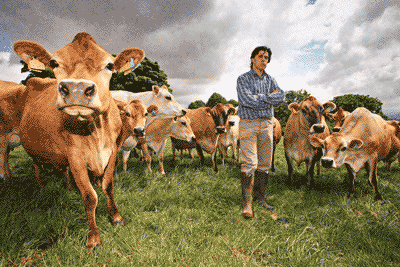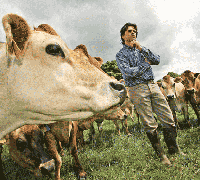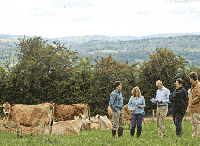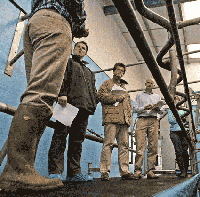FW Awards: North Wales Jerseys ahead of the clean, green game

FW Awards finalist Charlie Whittingham
Llanbedr Farm, near Ruthin, Denbighshire

Walk into the farmyard at Charlie Whittingham’s Llanbedr Farm and the first thing that strikes you is how clean everything is.
OK, it’s summertime and the cows are at pasture, but the place really is immaculate. The rubber flooring in the parlour is spotless, the milking equipment is gleaming, all the gates shut perfectly.
And when Charlie tips over a watering trough in one of the cubicle houses, to show how fast they refill – the water just glides off the carefully cambered concrete and makes its way to a drain.
His attention to detail is truly impressive. The collection yard leading up to the parlour – a 24:48 unit installed last winter – is deliberately sloped upwards. “Jersey cows don’t like going downhill, so this keeps them facing the right way,” he explains.
He is also mindful of the impact of his farm on his neighbours. New cubicle buildings for his 330 Jersey cattle are clad in brick to improve the aesthetics, while the slurry pit is screened off with newly-planted trees.
Beyond the farmyard, over 2.5 miles of hard tracks have been laid out, using the farm’s own shale, including some that run parallel to the road, so as to avoid having to stop the traffic.

Environmental management also features highly in Charlie’s list of priorities, and several hundred metres of new hedges have been planted in recent years, some with the aid of an RSPB grant to encourage yellowhammers. All woodlands and watercourses are fenced off.
But there would be no point in maintaining such an aesthetically pleasing farm if it was not working commercially and, on just about every measure, the business passes muster.
Charlie has farmed at Llanbedr since 1978 and used to have a herd of 130 pedigree Holsteins. It was one of the highest-yielding herds in Wales. But in 2004 he decided on a major change of tack, selling off 40 of his best cows to start converting to Jersey cattle.
“Everyone thought we had gone mad, but we had our reasons,” he says. “We were producing high yields of low-fat milk in a predominantly cheese-making area. We were being hit by high seasonality penalties and were faced with labour shortages.”
Charlie approached his buyer, Dairy Farmers of Britain, about the possibility of getting a Channel Island Contract and the positive feedback prompted him to make the conversion.
The first 80 Jerseys arrived from Denmark in June 2004, and in June 2005 he sold the rest of the black-and-white cows to build the Jersey herd up to 240. “We were successful in getting the Channel Island Contract in September 2005, and since then have built the herd up to 330 cows.”
A glance at the farm costings show what a prudent decision it has been.
The budget for this year anticipates a milk yield of 6000 litres, a price of 34p/litre and a gross margin of 18.2p/litre. Even allowing for the extra output from Holsteins, gross margin and enterprise profit are expected to be almost £50,000 higher under the Jersey system.
But, while the economics clearly stack up, Charlie says that converting to Jerseys was the right life-style choice. “What I didn’t like about the way we used to farm was that it was just a continuous slog. With a young family, it was a relief to move to a block calving system with commercial cows that require less maintenance.”
The system is kept as simple as possible. Calving starts outdoors on 20 August and is all but complete within nine weeks. Cows are housed full time from mid-November until mid-March, then go out on a New Zealand-style strip grazing system, with grass regularly measured using a plate meter.
Charlie also takes a keen interest in where his milk goes to and has been closely involved with the local cheese plant at Llandyrnog in developing branded Jersey Cheddar.
He is also keen to pass on his experience to others, hosting four open days last year. Llysfasi and Glyn Llifon agricultural colleges make regular visits, and for the past three years, Lanbedr Farm has been a demonstration farm for Gelli Aur College in North Wales.
With an eye on the future, Charlie still has growth in mind. “We would certainly like to expand a bit more – up to 350 cows. And we hope to install a wind turbine and water turbine, so we can process our own milk which could be marketed with a ‘low carbon footprint’ label.”
The fact that Llanbedr Farm has recently completed a carbon audit and come out with the lowest carbon emissions per litre of milk for any of Kite Consulting‘s farms shows that he is already well ahead of the game.

FARM FACTS
- 74ha (183 acres) owned, 11ha (27 acre)s rented
- Light sandy loam, to 150m altitude
- 330 Jersey cows producing 1.91m litres
- Family labour, relief milkers and contractors only
- New Zealand-style strip grazing with 4km (2.5 miles) of hard tracks

WHAT THE JUDGES LIKED
- Superb farm infrastructure and high health status cows
- Switching to Jerseys a brave decision that bucked the trend
- Full knowledge of costs
- Great sense of environmental and social responsibility
- Willingness to share knowledge with others
